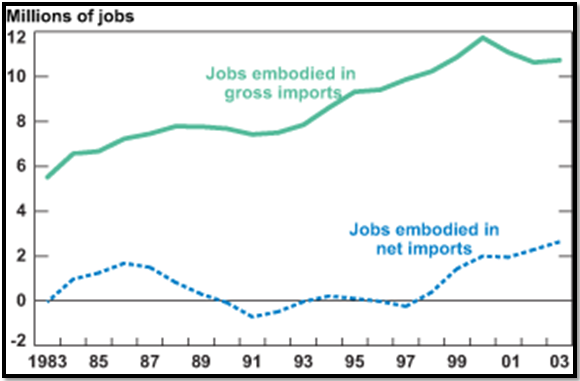China did not become a global manufacturing hub overnight and neither should India. That said, there are value-based reasons India should be the next manufacturing frontier.
Importing to support U.S. Business
As a U.S. business, jobs matter. Local manufacturing is a good thing. Selling those products to the rest of the world is even better. When jobs belong in the U.S., we all want them here. When outsourcing is appropriate, it still provides a great return on investment to U.S. business.
Protectionism is the theory or practice of shielding a country’s domestic industries from foreign competition by taxing imports. This policy generally fails because a company unable to source the most competitive products is likewise unable to compete against global competition in the marketplace.
Manufacturing, exports, and imports all support U.S. jobs. The NCPA points out imports in just the apparel and toy industries created over 570,000 jobs in 2010, in the fields of transportation, construction, retail, and finance. Furthermore, 78% of total value added to the products was in the U.S. so just 22% of dollars generated were sent abroad. These are jobs and dollars created by leveraging international opportunity and would either not exist or be less competitive without imports.
Importing can provide access to regionally exclusive resources, leverage unique manufacturing expertise, lower costs, and, in return, make your business more competitive in domestic and international markets. Cooperative efforts make you better able to not only boost profit margins but continue to competitively expand your U.S. business.

Source: Federal Reserve Bank of New York
Wage Wars
Reduced production costs are often a leading factor when purchasing products or services abroad. Wages in China have increased an average of nearly 13% per year since 1999 and minimum wages in China are now two to three times the level of their Indian counterparts. The spike in manufacturing costs has left many small and medium-sized manufacturers scrambling to recover lost profit margins.
In India, the development of a large, yet young labor force with an average age of 23 is motivated at lower salary levels. China, with an average worker age of 37, has a higher labor cost gap due to increasing health care costs and a more mature market. China has reached a demographic shift where it is becoming a consumer market rather than a global manufacturing hub.
As a buyer, you have a right to demand greater price stability and India delivers by providing the world’s fastest growing middle class, even at current salary levels. 82% have mobile phones, 77% own a TV, and the average family has a 30% savings rate. India already has discretionary income at current salary levels so there is less concern over rapid wage increases and you are less vulnerable as markets adjust.
The current devaluation of the rupee makes Indian prices even more attractive and small/mid-sized manufacturers are likely to find incentives available at lower purchase volumes than China would demand. Combine this with a skilled, empowered workforce, and you get both a better labor and lower costs.

Source: Dezan Shira & Associates
Rules & Regulation
Contracts in the USA are iron-clad. We like to walk in the door, figure out a deal, sign the contract, do the deal, and move on. Relationships are built through successful transactions. China’s view of contracts, conversely, is often referred to as “We Know Where You Live Capitalism”. Contracts are initiated after building a relationship, viewed as a fluid outline, and still open to negotiation after signing. Americans often experience frustration at the lack of value placed on signed contracts and many companies buy legal expertise to help them navigate contracts and legal implications of beginning a business relationship with China.
Both the U.S. and India have rules and regulations established during a period of British Colonial rule, which means there is more similarity in the value of contracts and a more defined beginning, middle, and end. British rule also brought India a parliamentary government, similar legal system, independent reserve bank, and fewer state-owned enterprises than China. An additional benefit that came during the British Colonial period is the infrastructure of a mature railway system that helps move goods more cheaply and easily throughout India so more sellers can competitively bid for your business.
It is easy to overlook rules and regulations when comparing China and India but these are business transactions and if you are failing to prepare, you are preparing to fail. American companies find value and cost savings in doing business with a country that operates under similar rules and regulations as well as offers a judicial process that is similar to our own. India is also a democracy so you have legal recourse, if needed.
Scandals, Bribes, & Fraud
Due diligence is essential while doing business abroad and mistrust is a primary reason businesses are reluctant to reach international markets. The sacrifice of not reaching abroad is that your business misses out on new markets, more innovative designs, and the ability to sell to 2/3rds of the world’s consumers.
Scandals and bribes do happen, even in the U.S., where it often occurs as financial fraud or insider trading activities. Transparency International publishes corruption data, which primarily occurs at government and political levels. These are not prevalent in mid-market deals.
Fraud is the major concern for small and mid-size businesses. The popular Chinese site, Alibaba, has confirmed millions of dollars in fraud cases, which arise from an inherent conflict of interest. E-Commerce buying has evolved but has not yet reached a level of maturity where international buying and selling is properly regulated. Fraud is properly mitigated by bringing on a representative to assist you. Once there is a local presence, the risk of fraud is drastically reduced.
Mutual Buying & Selling Opportunities
China earned its position as the world’s exporter based on demand from Europe and the USA but continues to struggle creating internal demand for many of the products and services it manufactures. Select, high-end brands are succeeding in China but most companies struggle to successfully reach Chinese consumers. Much of the U.S. profit derived from sales into China is earned by just a few companies.
India is the world’s fastest growing middle class consumer base. U.S. companies like Starbucks and Subway are doing well. Fossil and Brooks Brothers have recently been granted approval to set up business. India is the world’s newest stage for business expansion and it creates countless small business opportunities.
India is on pace to have the world’s largest population in just 15 years and 80% of the infrastructure to support that population still needs to be built. India will invest $143 billion in health care, $392 billion in transportation infrastructure, and $1.25 trillion in energy production to support its rapidly expanding population.
The economic boom is creating a new class of buyers that are looking for quality U.S. products and trade between the two countries is surging over $100 billion annually. The secondary benefit of manufacturing in India is the greater likelihood of creating market opportunities to also sell your product to the Indian consumer.
The Power of Communication
I recently spoke with a company that spent $100,000 on equipment they believed was necessary for a project. The specs had been misunderstood and that equipment is now collecting dust. Verbal and non-verbal actions are the foundation of communication and acceptable standards vary by region and nation. The official language of China, for example, is Mandarin and a thin layer of fluent English speakers are relied upon for virtually all import and export communication. The challenge is that the translator may not be an expert in your industry, product specs, or relaying cultural nuances. For example, due to the non-verbal concept of “mianzi” or “saving face”, it is rare to hear a direct “no” when demands cannot be met. Phrases like “Yes, probably” can be interpreted as positive but likely should be interpreted as the word “no”. The challenges become even greater when trying to ensure understanding of difficult technical specifications. The constant check-in for understanding on your end is both time-consuming and expensive.
Due to being a British colony until 1947, the two official languages of India are Hindi and English. Rather than a thin layer of English experience, most well-educated people speak English in India. Many of us lean on negative experience with Indian telemarketers but the fact remains that we can both give and receive information with these agents better than we can communicate with most Chinese businessmen. The direct benefit is the ability to connect with experts in your industry and speak more directly with the teams handling your project. Culture and checks for understanding are still important but there is a much smaller risk of specs being lost in translation. Moreover, the Indian contact is more capable of providing ongoing feedback throughout your project which can improve processes and save both time and money.
Utilizing professionals to bridge gaps is important when manufacturing or buying abroad but the commonalities between India and the U.S. are more familiar than the language and cultural divide with China. Choosing business partners abroad is a relationship and, as it is at home, communication is key to building and maintaining a strong relationship.
Negotiating Features, Materials, & Pricing
Negotiation is a fun topic to discuss in the U.S. because many are timid with negotiation and others have a very strong “I know what I’m doing” attitude. The challenge is that negotiation strategies differ from country to country and the only universal rule is that you better have a plan.
Negotiation is China is often referred to as the “cold shower” approach to decision making. Displays of anger and artificial deadlines seldom work and patience is a virtue. A larger challenge is that you may find yourself negotiating against a team on the opposite end of the table where you might struggle to identify the real decision maker and influencers. The entire process can be painstaking and requires you to stop, think, listen, sleep on it, and then perhaps make your decision. US buyers typically prefer to move swiftly through negotiations so the Chinese approach to patience often means you leave money on the table. Most challenging of all is that contracts in China are viewed as fluid documents so negotiation may be ongoing even after the contract is signed.
Indian negotiation is no less shrewd but a few simple rules can prepare you for success. First, contracts are similar to the U.S., with a defined beginning, middle, and end so you have greater clarity regarding the points to be negotiated. Second, everything is negotiable. The true price of any item is what you are willing to pay. Many initial price quotes are inflated by 30% – 70% so your discount is dependent on your ability to negotiate.
A great tip regarding India is that every transaction is negotiated and even strong negotiators benefit from engaging a professional. Hotmail founder Sabeer Bhatia, a California transplant, credits his bargaining skills to selling at the vegetable markets in Bangalore. His bargaining tactics enabled him to push the Microsoft acquisition price from $160M to $400M vs. Bill Gates and his team. Still think you can do the negotiation yourself?
Big Data
Data is important and advances in technology make it easier than ever to present valuable information showing the value of choosing India over China for most purchasing or manufacturing projects. The good news is that you do not have to just take our word for it. Feel free to link to several bright minds in U.S. – Asia relations.
- Bloomberg Data Analytics
- Academic Research at Wright State University
- Dezan Shira & Associates
- Federal Reserve Bank of New York
- The Heritage Foundation
- National Center for Policy Analysis
U.S. Companies with Operations in India

Interested in more information or have a question about sourcing a product, component, or business service? Get in touch…will be glad to hear from you.














